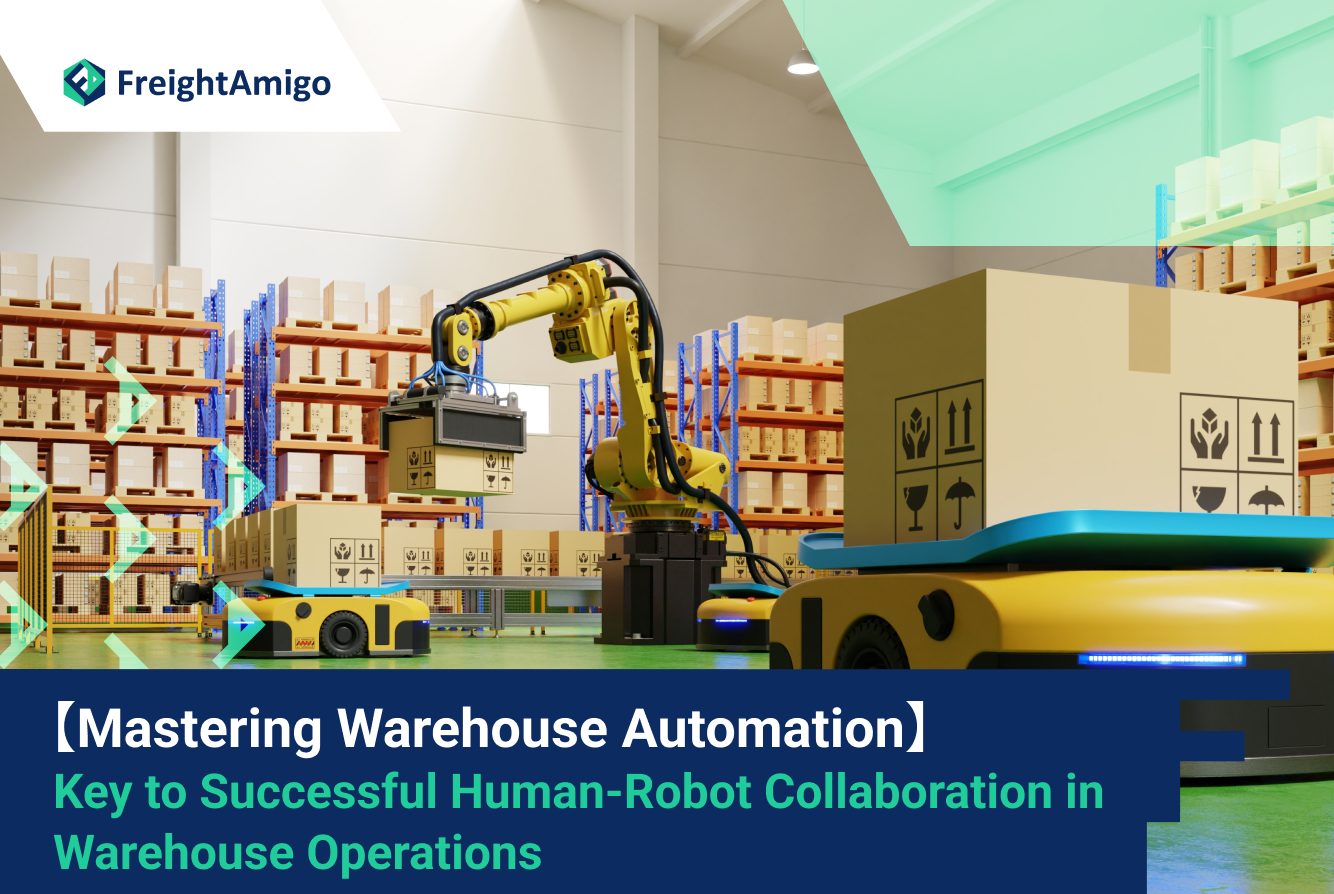Author Name: Tiffany Lee – Marketing Analyst at FreightAmigo
Warehouse automation has transformed the world of logistics. It’s a phenomenon that has revolutionized the way businesses handle and manage their inventory. In essence, warehouse automation refers to the use of technology and automated systems to perform warehousing tasks that were once performed manually. This encompasses everything from tracking inventory, order picking, to shipping and receiving.
The primary goal of warehouse automation is to streamline operations, increase efficiency, and reduce costs. It is a solution that has been embraced by businesses, large and small, in various industries around the globe. The implementation of warehouse automation systems has enabled these businesses to increase productivity, enhance accuracy, and improve customer service.
However, it’s essential to note that the success of warehouse automation doesn’t solely depend on the power of technology. It’s about creating a successful human-robot collaboration in warehouse operations. The interaction between humans and robots has to be in perfect harmony to ensure the smooth and efficient running of the warehouse.
Want To Compare The Best Express, Air Freight, Sea Freight, Rail Freight & Trucking Rates So As To Have Better Control On Cost?
Understanding Human-Robot Collaboration in Warehouses
Human-robot collaboration in warehouses is a relatively new concept. It involves the integration of automated machines, robots, and human workers in the warehouse. The objective is to use the strengths of both entities to maximize productivity and efficiency. The robots handle tasks that are monotonous, repetitive, or potentially dangerous, while humans oversee the operations and handle tasks that require decision-making, problem-solving, or a human touch.
The success of human-robot collaboration in warehouses heavily depends on the seamless integration of both parties. The robots should be user-friendly and easy to operate. On the other hand, human workers should receive proper training to handle these machines effectively and safely.
Moreover, there should be a healthy balance between the roles of humans and robots in the warehouse. Over-reliance on either party could lead to inefficiencies or even accidents in the warehouse. So, it’s essential to strike a balance in this collaboration for the success of warehouse automation.
Benefits of Warehouse Automation
There are numerous benefits of warehouse automation that make it a worthy investment for any business. First and foremost, it significantly improves operational efficiency. With the automation of repetitive tasks, businesses can save time and reduce the chances of human error. This leads to increased productivity and, consequently, increased profits.
Another notable benefit of warehouse automation is the reduction of labor costs. With automated systems handling most of the tasks, businesses can reduce their dependence on manual labor. This translates to lower labor costs, which directly impacts the bottom line.
Furthermore, warehouse automation enhances accuracy in inventory management. With the use of technology, businesses can keep real-time track of their inventory, minimizing the risk of stock-outs or overstocks. This leads to better inventory management and improved customer satisfaction.
The Role of Balance in Successful Human-Robot Collaboration
The role of balance in successful human-robot collaboration cannot be understated. It’s the perfect blend of human intelligence and robotic precision that makes warehouse automation successful. Too much reliance on either party could lead to inefficiencies or even accidents in the warehouse.
The key to achieving balance in human-robot collaboration lies in clearly defining the roles of each party. Robots should handle tasks that are monotonous, repetitive, or potentially dangerous. On the other hand, human workers should oversee the operations and handle tasks that require decision-making, problem-solving, or a human touch.
Moreover, there should be a healthy level of interaction between humans and robots in the warehouse. This fosters a working environment that is conducive for both parties, promoting efficiency and productivity in the warehouse.
Top Warehouse Automation Systems for Your Business
When it comes to warehouse automation systems, businesses are spoilt for choice. There are numerous systems available in the market, each with its unique features and benefits. However, it’s essential to choose a system that aligns with your business needs and goals.
For instance, Automated Storage and Retrieval Systems (AS/RS) are ideal for businesses with high-volume, high-density storage needs. They are highly efficient and can significantly reduce labor costs.
On the other hand, Conveyor and Sortation Systems are perfect for businesses that require rapid movement of goods within the warehouse. They are fast, reliable, and can handle a wide range of product types and sizes.
Moreover, businesses that require accurate and efficient order picking may consider Goods-to-Person (GTP) technology. This system brings the required items to the picker, reducing travel time and improving picking accuracy.
Safety Measures in Warehouse Automation
While warehouse automation brings numerous benefits, it also presents certain risks, especially when humans and robots work together. Therefore, it’s crucial to implement safety measures in warehouse automation to protect workers and ensure smooth operations.
Firstly, all workers should receive proper training on how to operate and interact with the automated systems. They should understand the potential risks and how to mitigate them. Furthermore, warehouses should be designed with safety in mind, ensuring clear paths for robots and safe working areas for humans.
Moreover, automated systems should be equipped with safety features such as sensors and emergency stop buttons. These features can prevent accidents by detecting obstacles or stopping the machine in case of an emergency.
Training for a Successful Automation in Warehouse Operations
Training plays a crucial role in the successful implementation of automation in warehouse operations. It’s not enough to invest in advanced automation systems; workers need to be adequately trained to operate these systems effectively and safely.
The training should cover various aspects, including the operation of the automated systems, safety procedures, and maintenance routines. It should also emphasize the importance of human-robot collaboration and how to achieve a balance in the warehouse.
Moreover, the training should be ongoing to accommodate new hires and refresh the knowledge of existing workers. This ensures that all workers are up-to-date with the latest procedures and safety measures in the warehouse.
Future Trends in Warehouse Automation
The future of warehouse automation looks promising, with several exciting trends on the horizon. One such trend is the increased use of artificial intelligence (AI) in warehouse operations. AI can analyze data, predict trends, and make decisions, enhancing the efficiency and accuracy of warehouse operations.
Another noteworthy trend is the use of autonomous mobile robots (AMRs). These robots can navigate around the warehouse independently, picking and transporting goods without human intervention. This not only improves efficiency but also reduces the risk of accidents in the warehouse.
Moreover, the Internet of Things (IoT) is expected to play a significant role in warehouse automation. With IoT, businesses can connect all their devices and systems, allowing them to monitor and control their operations remotely.
Conclusion
In conclusion, mastering warehouse automation is key to successful human-robot collaboration in warehouse operations. It’s about harnessing the power of technology and integrating it with human intelligence to streamline operations, improve efficiency, and reduce costs.
However, it’s essential to strike a balance in this collaboration, with clearly defined roles for both humans and robots. Safety measures should also be implemented to protect workers and ensure smooth operations.
With the right approach and the right technology, businesses can reap the numerous benefits of warehouse automation and set themselves up for success in the competitive world of logistics. So, embrace warehouse automation today and take your warehouse operations to the next level.
There Are Different Options For Cargo Transportation. If You Want To Choose The Most Convenient And Suitable Solution, It Is Best To Have The Full Support Of Logistics Experts! If You Are Planning To Ship Goods Overseas, Please Go To The FreightAmigo Page For Inquiries.
===
Read More:
【Logistics News】Singapore to Sign Declaration on Green Shipping Corridors
FreightAmigo Won Startup Grand Award In TechChallenge — Digitising Trade Finance
Sailing Schedule: Streamlining Logistics Operations for Efficient Shipments
===
If you have any inquiries on logistics/supply chain, feel free to contact FreightAmigo now:
Chat with us online OR
Phone : +852 28121686
WhatsApp: +852 27467829









































